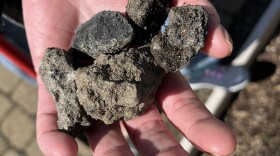If you spend time tending a garden, chances are that you’ve come across some insects you don’t know. Other times there may be bugs you think you know and may be tempted to get rid of. Henry Homeyer argues that that’s not always the best thing to do. Homeyer is a lifelong organic gardener living in Cornish Flat. He’s the author of four gardening books and writes a weekly gardening column for ten newspapers around New England. I spoke with Homeyer on Thursday:
Want to learn more about plants with Henry Homeyer? Click here for his blog.
Henry, it’s mid-summer and gardens are established now. What are you doing in your garden?
Well, of course, I’m pulling a few weeds, and I’m planting a few perennial flowers because any time I see a new perennial I have to have it. But, most importantly, in my vegetable garden right now I’m harvesting potato beetles.
Is this an annual event for you?
It is. The potato beetle is a voracious eater, not only the beetle but the larvae as well. They strip the leaves off of your plants and without leaves there is no photosynthesis and no spuds. So I pick them and put them in soapy water. This makes a huge difference.
What other pests should we be looking for?
Slugs and snails are well known and hated everywhere. I’ve also heard that many people are having trouble with Japanese beetles this year. Any bug or beetle is better picked if you can do it, if you don’t have five acres of commercial tomatoes for example. It’s much better to pick them because there are good bugs along with the bad bugs, and you don’t want to put a spray down that kills everybody.
What bugs are good bugs to have in your garden?
Everybody knows that ladybugs are wonderful because they eat aphids. There are lots of others, which I call UFIs, Unidentified Flying Insects. Though they can be very useful, many gardeners have an inclination to squish them, submerge them or get rid of them one way or another. Lacewings are very beautiful insects. They’re light green and their wings are diaphanous, you can usually see them at night, drawn to light on a screened porch. The assassin bug is a half inch long black bug that’s quite hairy and looks quite scary.

With a name like assassin bug you think, “This is not good.”
But it is good.
Are there insects that we’re likely to see at this time of year or later in the summer that we just don’t have to deal with earlier in the year?
Absolutely. The dreaded tomato hornworm is coming. It’s a long larval form of a moth that’s light green and can grow up to five inches long. They can be very aggressive and they have a horn on their rear end which gives them the name. They can really chew up your tomatoes. But, there’s a good thing. They can be parasitized by a wasp that lays its eggs on the tomato hornworm larva. If you see things that look like little grains of white rice on the back of the tomato hornworm, it’s being eaten up by the larvae of this parasitic wasp. So, instead of killing it and putting it in your soapy water, you pick it up and put it in some other part of your property. That way, the parasitic wasps can go through their life cycle and make more parasitic wasps.
So you want to cultivate the parasitic wasps.
Yes, they’re good.
Every year around this time I see neighbors putting up Japanese beetle bags. What damage can these beetles do?
It’s a foreign invader, introduced to the United States about a hundred years ago. It’s a voracious eater that loves roses, grapes, plum trees and will eat leaves and damage flowers. They can easily be picked and put in soapy water if you do it early in the morning when they’re still groggy, before they’ve had their first cup of coffee.
What about using those commercially available bags?
The problem with the bags is that they attract so many beetles, including your neighbor’s beetles. You could fill up your bag and still have all of your neighbor’s beetles eating your plants. What I like to tell people, jokingly of course, is give the bags to your neighbors of the opposite political party and their bags will attract your beetles.

Do you have any advice on insect control for a novice?
Yes. Don’t be squeamish. Get out there, pick those bugs and put them in soapy water. After a while you’ll be squishing them with your fingers and washing your hands later. The main thing is don’t go for the chemical poisons; avoid the row at the garden center which I call death row. They’re not good for you, they’re not good for the balance of the ecosystem, and they’re not good for your dogs, cats or grandchildren. So stay away from chemicals and try to do it as naturally as you can.
Have a question for Henry Homeyer? Email him here.








